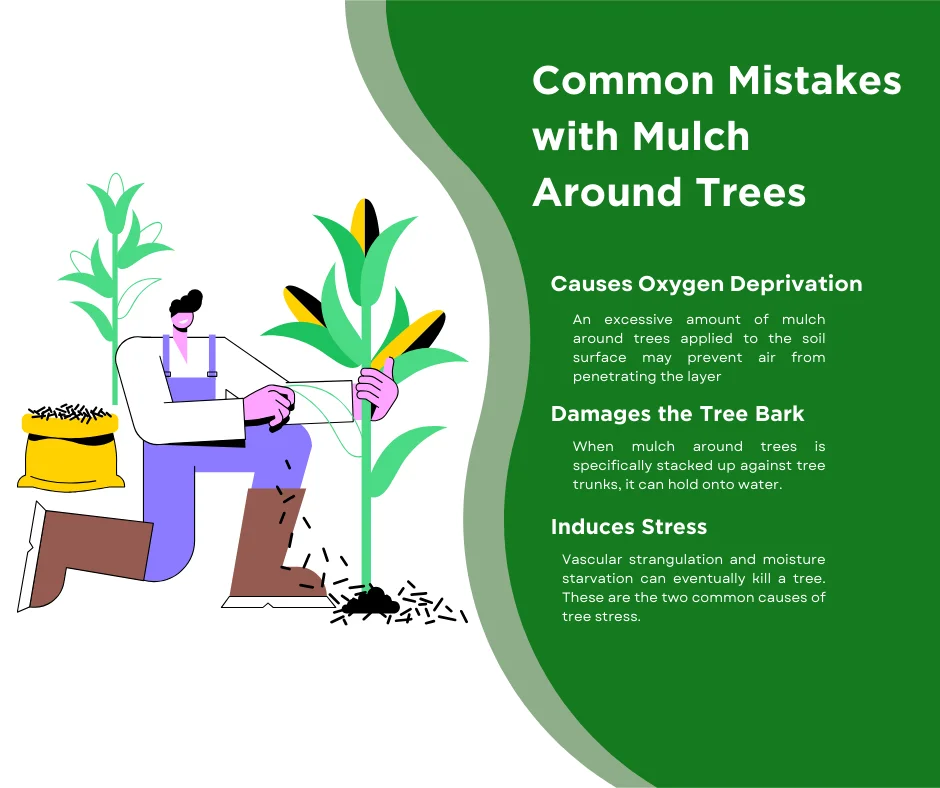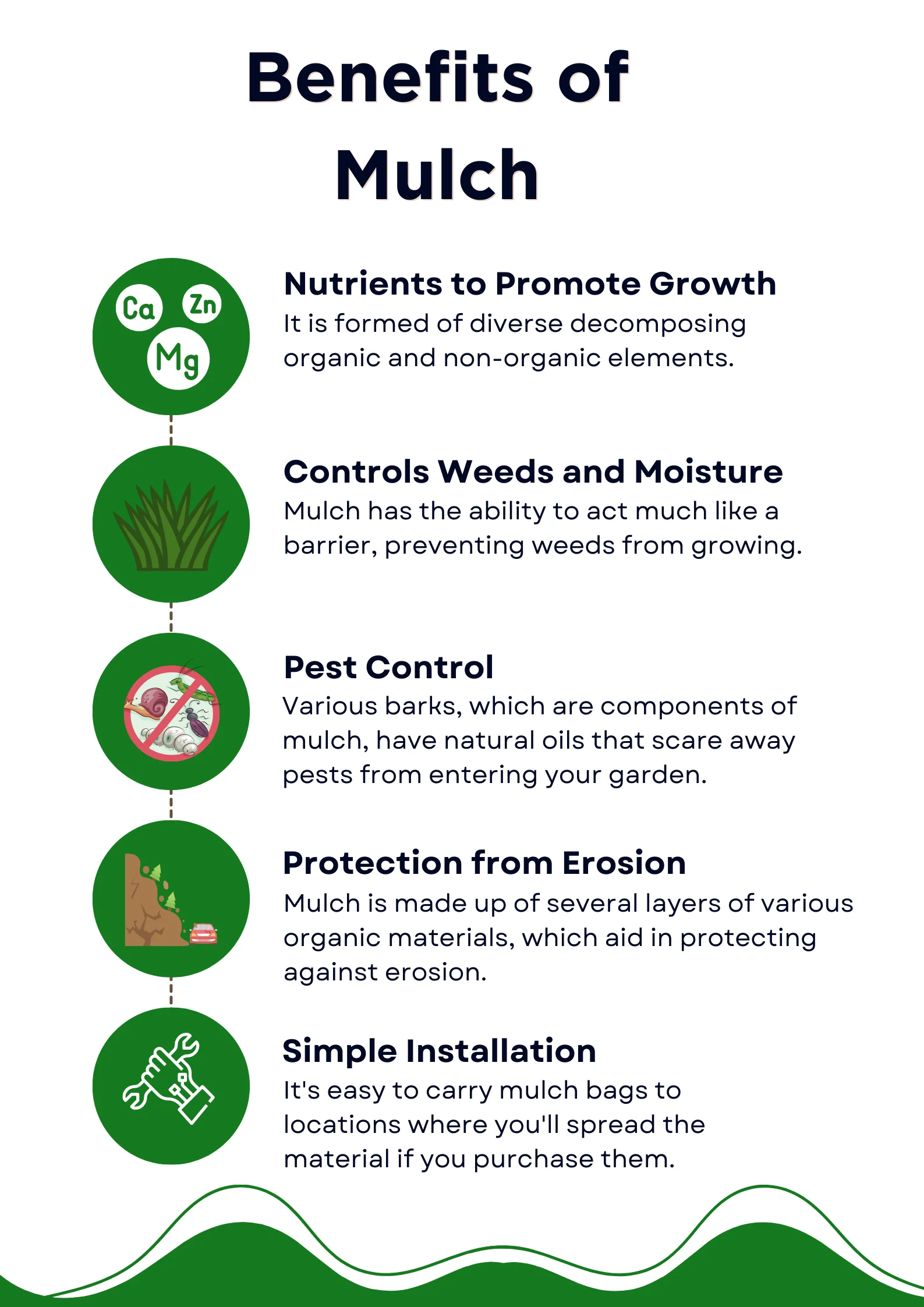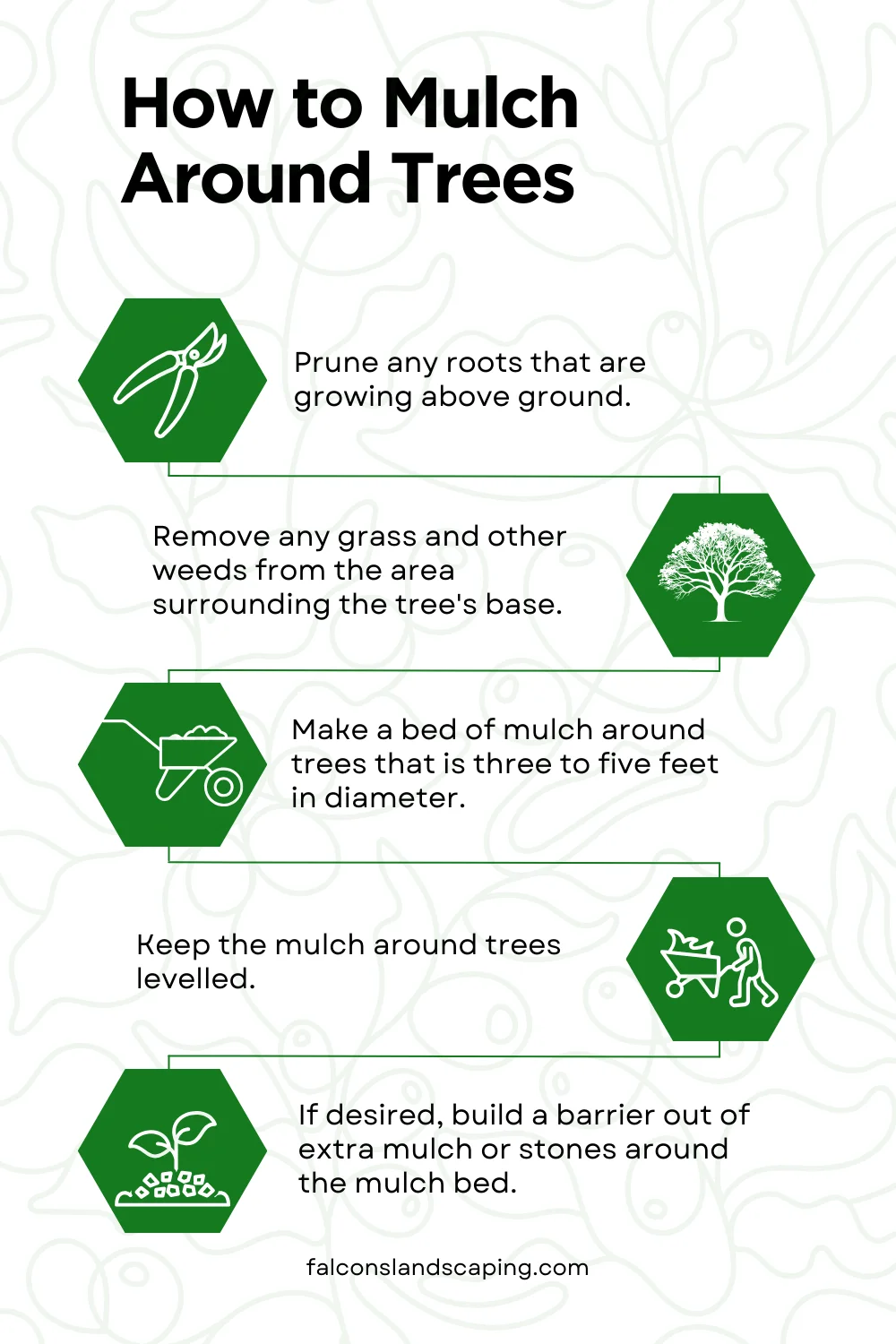If you are noticing that your yard is dying due to a disease, by making some changes, you can reverse it. Sometimes, homeowners make common gardening mistakes that have a negative appeal on the yard.
For instance, the incorrect use of fertilizers, over-watering, or the wrong way of mulching can all turn your beautiful lawn into bundles of hay.
Luckily, with our gardening hacks and tips, you can fix your rough lawn after a few weeks of hard work.
Today, we will cover the topic of mulch around trees so you can become a skilled player in the long game of lawn care.
Types of Mulch Around Trees
There are two main types of mulch around trees: inorganic and organic because organic mulches break down and improve soil structure and fertility.
According to experts, the mulch around trees made of wood chips, pine needles, hardwood and softwood bark, cocoa husks, leaves, and compost blends is more useful.
Different organic mulches break down at different rates and need to be reapplied occasionally. Because they don’t break down, inorganic mulches like gravel, stone chips, river rock, and rubber mulches have different properties than organic mulches.
To learn more about mulch around trees and other landscape options, read Mulch Vs Rock (2024 Comparison).
Common Mistakes with Mulch Around Trees

If you care for your trees and yard, you may have seen some people in the neighbourhood pilling up heaps of mulch around trees.
The saddest part about this monstrosity of mulch around trees is that once a person sees it in a yard, they feel urged to try it without thinking it through.
The term mulch volcano is used to characterize the overabundance of mulch applied to trees disparagingly.
Despite their ignorance, you have undoubtedly seen them in public areas and on people’s lawns since they are rather widespread.
If people knew about the deleterious effects of volcano mulch around trees, they would stamp out this practice.
Usually, people build circular raised beds around their trees and then fill them with mulch, resulting in a mulch volcano.
The mulch becomes increasingly steeper as it approaches the tree, which emerges from the centre, resembling a lava explosion.
The disadvantages of excessive mulch around trees can be the following:
1. Causes Oxygen Deprivation
For tree roots to develop and work correctly, oxygen is necessary.
An excessive amount of mulch around trees applied to the soil surface may prevent air from penetrating the layer.
Consequently, the underlying soil loses oxygen.
Furthermore, mulch that is too deeply buried may prevent water from evaporating.
The diffusion of oxygen into the soil is effectively stopped once the pore spaces in the soil are filled with water.
Root growth is inhibited when soil oxygen levels fall too low, which prevents the plant from absorbing water and nutrients.
If too many roots die, the plant will die slowly, and you won’t even know about it.
2. Damages the Tree Bark
Tree bark is the dry tissue that shields trees from many threats, including oxidation, dehydration, and direct plant pest and disease access to the living tissue below.
When mulch around trees is specifically stacked up against tree trunks, it can hold onto water.
That increases the bark’s moisture content and causes it to rot.
Imagine what would happen to your face if the skin gets severely damaged. The same thing will happen to the tree in your backyard.
3. Induces Stress
Vascular strangulation and moisture starvation can eventually kill a tree. These are the two common causes of tree stress.
Mulch around trees can cause both these problems that later result in tree stress.
The Advantages of Tree Mulching

Mulch around trees allows the other plants in your environment, including your recently planted trees, to flourish.
When you mulch around trees, you get these benefits:
- Aids in the soil’s moisture retention
- Enhances the nutritional value of the soil
- Promotes development
- Stops weeds from vying with tree roots for nutrients and water
- Prevents compacted soil by reducing foot and vehicle traffic, allowing roots to breathe
- Shields roots from extreme weather
Learn More: Natural Solutions for an Attractive Lawn: Organic Lawn Care 101
Steps on How to Mulch Around Trees

Here are the steps to mulch around trees without any mistakes:
1. Prune the Roots
Prune any roots that are growing above ground.
Overgrown roots have the potential to swaddle the base of the tree and ultimately cause it to die.
Mostly, growing roots indicate an oxygen shortage in the tree.
2. Eliminate Weeds
Using a gardening claw or spade, remove any grass and other weeds from the area surrounding the tree’s base. To avoid competing for nutrients, make sure the area is completely free of weeds when you mulch around trees.
3. Apply the Mulch
Make a bed of mulch around trees that is three to five feet in diameter.
Make sure it doesn’t come into contact with the tree trunk when you apply it thinly.
Give the mulch around trees and the base of the tree a spacing of one or two inches.
4. Maintain the Depth
Mulch should be applied in layers until it is 2 to 4 inches deep. Rather, keep the mulch around trees levelled. This is a crucial step that makes a lot of difference.
5. Create a Boundary
If desired, build a barrier out of extra mulch or stones around the mulch bed.
Create a barrier around the perimeter of your mulch around trees by piling on an additional 1 inch of mulch. This stops the mulch from washing away in a wind storm or rain.
FAQs
Does mulch around trees prevent weeds?
It doesn’t prevent weed from growing. It actually kills weed by suppressing it.
What are the first steps of applying mulch around trees?
Cleaning the debris, removing weeds, and tilling the soil.
Does mulch around trees attract insects and pests?
Various types of mulch can be a source of food for insects and pests.
Final Words
Whether you are applying new mulch around trees or replacing the previous one, make sure you use the right method.
The best technique for it is to clean the area, avoid over-mulching, and maintain a good distance between the base of the trees and mulch.
After you are done, keep the roots moist and the trunk dry. And rake it after three to four months.
If you think you can’t do it yourself, you can leave it to Falcons Landscaping. You can get a free quote from us and discuss your requirements whenever you want.

